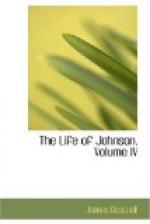I shall now fulfil my promise[1176] of exhibiting specimens of various sorts of imitation of Johnson’s style.
In the Transactions of the Royal Irish Academy, 1787, there is an ‘Essay on the Style of Dr. Samuel Johnson,’ by the Reverend Robert Burrowes, whose respect for the great object of his criticism[1177] is thus evinced in the concluding paragraph:—
’I have singled him out from the whole body of English writers, because his universally-acknowledged beauties would be most apt to induce imitation; and I have treated rather on his faults than his perfections, because an essay might comprize all the observations I could make upon his faults, while volumes would not be sufficient for a treatise on his perfections.’
Mr. BURROWES has analysed the composition of Johnson, and pointed out its peculiarities with much acuteness; and I would recommend a careful perusal of his Essay to those, who being captivated by the union of perspicuity and splendour which the writings of Johnson contain, without having a sufficient portion of his vigour of mind, may be in danger of becoming bad copyists of his manner. I, however, cannot but observe, and I observe it to his credit, that this learned gentleman has himself caught no mean degree of the expansion and harmony, which, independent of all other circumstances, characterise the sentences of Johnson. Thus, in the Preface to the volume in which his Essay appears, we find,—
’If it be said that in societies of this sort, too much attention is frequently bestowed on subjects barren and speculative, it may be answered, that no one science is so little connected with the rest, as not to afford many principles whose use may extend considerably beyond the science to which they primarily belong; and that no proposition is so purely theoretical as to be totally incapable of being applied to practical purposes. There is no apparent connection between duration and the cycloidal arch, the properties of which duly attended to, have furnished us with our best regulated methods of measuring time: and he who has made himself master of the nature and affections of the logarithmick curve, is not aware that he has advanced considerably towards ascertaining the proportionable density of the air at its various distances from the surface of the earth.’




